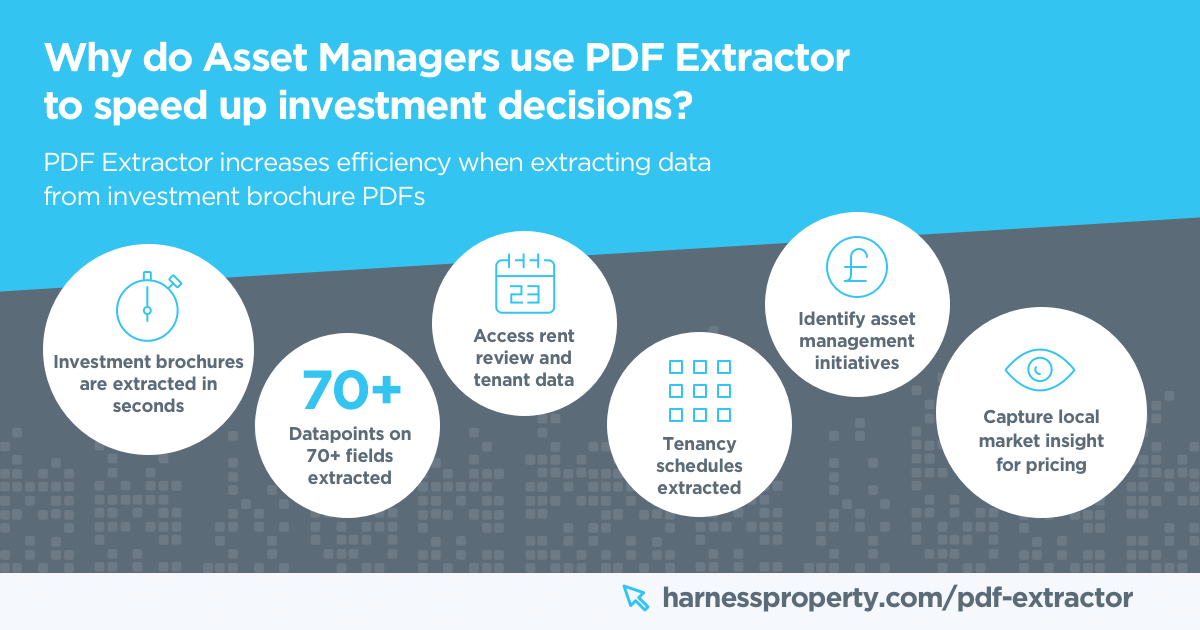It’s not just commercial real estate agents who extract data from CRE investment brochures, asset managers also use this data to make a variety of decisions.
To enable asset Managers to advise their clients on how to maximise the return on their assets (such as property investments) they need a whole host of data, and they need this data in a structured format in order to be able to analyse it.
Investment brochures and tenancy schedules contain large amounts of valuable information, which provide asset managers with insight they can use to advise their clients in order to maximise investor returns. They constantly assess whether property assets are generating a good return, or if it could be higher.
Methods asset managers use to maximise returns from property
ENSURING PROPERTIES ARE FILLED WITH QUALITY TENANTS
Tenants that are considered to be lower risk are those with high liquidity or in a stable industry. If an industry is known to be struggling it’s important to be aware, as that could impact a tenant’s business and increase the likelihood of them not being able to afford their rent or needing to vacate the property. Asset Managers will look to find reliable tenants who are at low risk of insolvency. Tenancy schedules provide information on a building’s occupiers, and are therefore a good source of this information.
CONDUCTING RENT REVIEWS
A rent review is an opportunity to align the amount tenants are charged with the market. If a property has not been subject to one for a while it may be that more revenue could be obtained by increasing the asking rent. This can only take place at certain times during the tenancy, so it’s valuable information to gather from investment brochures and tenancy schedules.

LOOKING FOR ASSET MANAGEMENT OPPORTUNITIES
It may be that the addition of certain features to a property, or the upgrading of some of its facilities could increase the likelihood of it attracting a higher rent. By understanding the property’s state of repair and amenities, as well as that of comparable buildings, an asset manager can advise on whether it’s worth making certain improvements to increase the return. The reversionary yield provides an indication of how much more value could be extracted if changes were made to the property, and provides a valuable advisory opportunity for asset managers to present to investors.
CHANGING THE USE CLASS
Commercial properties are allowed to be used for specific purposes, denoted by their use class. It may be more profitable to change the use class of a building, which an asset manager will attempt to determine from the investment brochure.
USING LOCAL MARKET INSIGHT
It’s extremely useful to have data on how much similar properties in the local area are charging for rent. This provides benchmarking information which can be used to inform pricing decisions, particularly when a rent review is due.
SPEEDING UP INVESTMENT DECISIONS ON NEW OPPORTUNITIES
PDF Extractor takes the hassle out of manually extracting data from tenancy schedules and investment brochures. In the time it would take a human to extract one 20-page investment brochure, PDF Extractor can capture 70+ data points from 1,200 brochures, saving the researcher a considerable amount of time. In instances where a large number of historic brochures need extracting to provide access to valuable insight and data, the sooner a business has access to this structured information the earlier they can start making decisions and increasing their returns.
To learn more about PDF Extractor contact us at info@hanessdata.ai for a free demo.








